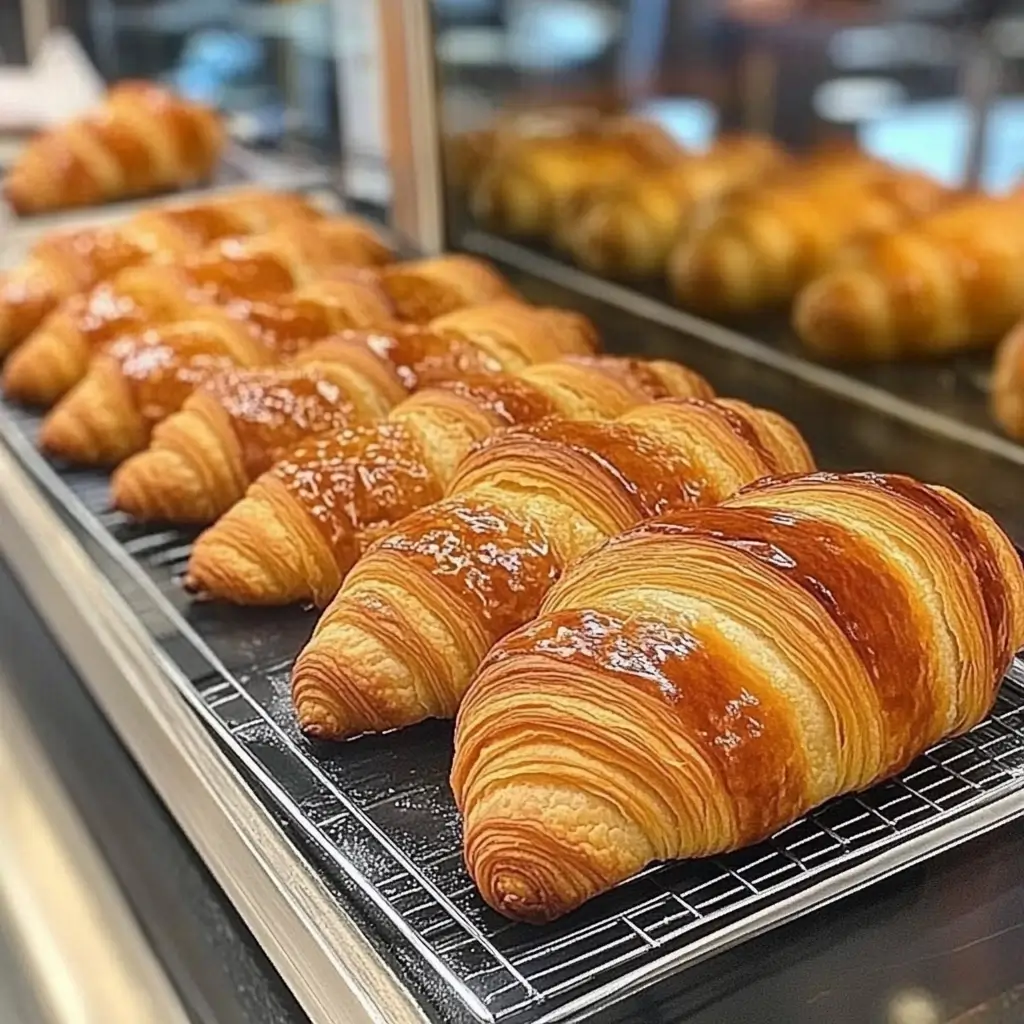The secret to a good croissant lies in a perfect blend of technique, patience, and quality ingredients. Whether you’ve marveled at the buttery, flaky layers of a bakery croissant or dreamt of crafting your own, the journey begins by understanding this timeless pastry. Mastering the secret to a good croissant involves selecting the right butter, ensuring precise lamination, and carefully managing every step of the baking process.
This guide reveals the secret to a good croissant through seven proven tips, helping you achieve bakery-quality results in your own kitchen. From choosing high-fat butter to perfecting the final proof, we’ll explore everything you need to know to unlock the mystery behind this iconic French pastry. Are you ready to discover the ultimate secret to a good croissant? Let’s dive in!
1. The Croissant’s Charm and Heritage
Croissants may be synonymous with France, but their origin story takes us on a winding historical path. Early forms of layered pastries can be traced to Austrian and Central European baking traditions. The kipferl, a crescent-shaped bread popular in Austria, is often considered an ancestor to the French croissant. Over time, these pastries evolved—gaining additional layers of butter, a lighter crumb, and eventually the name “croissant,” reflecting the crescent shape.
By the mid-19th century, bakeries in Paris were consistently producing delicate, flaky croissants, quickly turning them into a breakfast staple. Today, they’re one of the most iconic items on any French café menu, symbolizing the meticulous artistry behind the seemingly simple wonder of laminated dough. It’s often said that croissants embody the cultural spirit of French baking: refined, patient, and exacting, yet irresistibly approachable once you sink your teeth into that crisp, buttery crust.
However, croissants aren’t locked behind Parisian shop windows. Aspiring home bakers worldwide have discovered they can recreate that same magic, provided they pay close attention to technique and invest time in mastering the steps. That’s the true allure: once you’ve prepared a flawless batch, you realize the wonders of French pâtisserie can be accessed anywhere, as long as you’re willing to learn.
2. Essential Ingredients and Their Roles
A croissant’s enchantment depends on only a few basic items: flour, yeast, salt, sugar, water (or milk, in some recipes), and real butter. Yet each element makes a distinct contribution to the dough’s final texture and taste:
- Flour: Flour forms the backbone of your dough. Many bakers prefer a moderate-protein flour—often a combination of all-purpose and bread flour—to create enough gluten for structure without producing a tough or bready result.
- Yeast: Whether you use fresh, active dry, or instant yeast, this microorganism ferments the dough, releasing carbon dioxide that lightens the pastry’s crumb.
- Salt: Beyond enhancing flavor, salt tightens gluten strands, helping them hold shape during rolling and baking.
- Sugar: A touch of sugar feeds the yeast and sweetens the overall profile of the pastry. This isn’t a sugary dough, but the bit of sweetness helps give the croissant its subtle, inviting taste.
- Butter: Often considered the crown jewel, butter is what transforms an otherwise standard roll into a laminated masterpiece. High-fat, European-style butter remains the gold standard because of its elevated flavor and lower water content.
While you might improvise in other baking endeavors, croissants don’t yield well to guesswork. Measurements—especially in grams—are critical, so invest in a kitchen scale if you haven’t already. The interplay among these ingredients, combined with the method of folding layers of butter into dough, is truly where the magic happens.
3. Dough Preparation and Gentle Kneading
At first glance, preparing croissant dough may feel akin to making bread dough. You activate the yeast, incorporate the liquids and dry ingredients, and gently knead until the mixture forms a cohesive mass. Yet there’s a pivotal difference: you must develop enough gluten so the dough can be stretched and folded repeatedly, but not so much that it becomes dense and resistant.
- Initial Mix
Begin by combining flour, sugar, salt, yeast, and a portion of your liquid (often water or milk). Some bakers favor using chilled milk to help maintain a cooler dough. Once the ingredients come together, you can knead by hand or with a stand mixer on low speed. The dough should feel slightly tacky, but not overly sticky. - Hydration and Autolyse
If you have time, consider briefly resting the dough (called autolyse) after initial mixing. This rest allows the flour to hydrate, improving its extensibility and making kneading more efficient. - Gentle Gluten Development
Croissant dough needs enough body to endure several laminations (folds) without tearing. However, overzealous kneading will produce a tight, rubbery dough that fights you. Aim for moderate gluten development: it should feel springy yet flexible. - First Proof
Once you have a smooth dough, shape it into a ball and let it proof. The dough may double in size within 1–2 hours, based on room temperature. Some bakers prefer a slow, overnight fermentation in the refrigerator, which not only develops flavor but also ensures the dough is cool when it’s time to incorporate butter.
This initial dough stage lays the foundation for the croissant’s interior crumb and flavor complexity. A balanced approach ensures enough structure to support all those buttery layers without turning tough or chewy.
4. The Art of Lamination
Lamination is the heart and soul of croissant-making, where you integrate cold butter into the dough through multiple folds (turns). Each fold exponentially increases the layers of dough and butter. Ultimately, this is what yields the unmistakable flaky texture.
- Creating the Butter Block
Typically, you’ll flatten and shape butter into a rectangle (often called a beurrage). European-style butter with a higher fat content is more pliable, so it’s less likely to crack when chilled. Aim to have this butter block at a workable consistency—firm but bendable. - Encasing Butter
After your dough has rested, roll it into a rectangle that can wrap around the butter block. Place the butter slab in the center of the dough, then fold the dough’s edges over to seal it in completely, preventing any butter leakage. - First Fold (Letter Fold)
Roll out the dough-butter package into a longer rectangle, maintaining consistent thickness, then fold it into thirds like a letter. That’s your first turn, effectively tripling your layers. - Subsequent Folds
After a brief chill, rotate the dough 90 degrees. Roll it out again, fold it into thirds, then chill. Some croissant recipes call for three total “turns,” although variations exist. Each turn multiplies your layers, turning a simple dough-butter sandwich into a finely layered pastry. - Patience Is Key
Rushing lamination is a shortcut to disaster. If the dough and butter warm up too much, the butter melds into the dough, losing distinct layers. Chilling after each turn re-solidifies the butter, preventing leaks and preserving the lamination’s integrity.
Well-executed lamination is mesmerizing. You’ll watch these layers swell in the oven, creating that delightfully airy texture that splits into dozens of delicate sheets. Mastering lamination is truly central to understanding what is the secret to a good croissant?
5. Temperature Management During Lamination
One of the most common stumbling blocks when preparing croissants is mismanaging temperature. If your kitchen is sweltering, the butter can melt swiftly, merging with the dough and sacrificing those pristine layers. On the flip side, working in an environment that’s too cold can make the dough stiff, leading to rips and tears.
- Chilling Intervals
After each fold, refrigerate the dough for around 20–30 minutes. This pause does two crucial things: re-chills the butter and relaxes the gluten. If you notice your dough or butter feeling excessively soft during folding, don’t hesitate to pause, cover, and chill until they’re workable again. - Consistent Butter and Dough Textures
Aim to have the butter and dough at similar consistencies. If the butter is too firm relative to the dough, it can break into chunks, ruining the even distribution. If the dough is too firm, you risk tearing while rolling. Practice will help you recognize that sweet spot in texture. - Monitoring Environment
Try to keep your workspace at a moderate temperature—around 68–72°F (20–22°C) if possible. If it’s a particularly warm day, consider using a marble pastry board or refrigerate your rolling pin to help keep the dough cool. - Overnight Rest
Some bakers like to extend the process over two days, performing a few folds one day and letting the dough rest overnight before completing the final turn. This approach deepens flavor and can simplify the workflow, especially if your schedule is tight.
Ultimately, temperature control isn’t just about comfort; it’s pivotal for preserving the individual, steam-producing layers that set croissants apart from ordinary rolls.
6. Shaping and Final Proof
Once you’ve done all the folds (turns), you’ll roll the dough one last time to create the final sheet from which you’ll cut and shape croissants. This moment reveals all your lamination efforts, and with the correct thickness, you’ll capture those beautiful layers in every slice.
- Cutting Triangles
Carefully trim the edges of your dough to get neat borders, which helps the croissants open up more evenly in the oven. Then, cut long triangles, typically 3–4 inches wide at the base and around 7–8 inches long. Some prefer narrower triangles for smaller, tighter croissants, while others like a broader base for fuller pastries. - Rolling Technique
Starting from the base of the triangle, gently stretch the dough as you roll toward the tip. This process ensures each croissant retains those carefully cultivated layers. You can choose to leave them straight or bend them into a crescent shape, depending on tradition or personal preference. - Final Proof
Once shaped, place them on a parchment-lined baking tray, leaving enough space for expansion. Proof the pastries at a mild temperature—around 75–78°F (24–26°C)—for about 1–2 hours, or until they look puffed and jiggly when the tray is nudged. Overproofing causes them to deflate during baking, whereas underproofing yields denser pastries. - Egg Wash Prep
Just before baking, gently brush the tops with an egg wash (one beaten egg plus a splash of milk or water). This step is optional, but it imparts a glossy, golden finish that’s hard to resist.
Shaping and final proof represent the last stretch of your effort before you taste that remarkable transformation from dough to pastry. Done right, you’ll see the dough swell beautifully during proofing, hinting at the airy crumb that awaits.
7. Baking Techniques and Finishing Touches
Croissants thrive in relatively high heat, which quickly transitions the water in the butter into steam, lifting each layer. Achieving a crisp shell without drying the interior can require some subtle temperature adjustments based on your oven’s quirks.
- Oven Temperature
Preheat your oven to around 375–400°F (190–205°C). Some bakers start at a higher temperature for the first few minutes to encourage a hearty oven spring, then lower it to prevent over-browning. - Bake Duration
Croissants generally bake for 15–20 minutes, depending on size and oven performance. Rotate your trays halfway through for even coloring. Watch carefully—too dark and you risk bitterness, too light and the pastries may end up doughy in the center. - Assessing Doneness
A well-baked croissant appears deeply golden and feels feather-light for its size. Tapping the underside should yield a hollow sound, indicating the interior is fully baked. Let them cool slightly on a wire rack so the crumb can set before diving in. - Finishing Flourishes
Consider sprinkling seeds (poppy, sesame) or sliced almonds on top after applying the egg wash. For sweet variations, a drizzle of simple syrup right out of the oven can add a subtle shine and sweetness. Or, go one step further and transform your pastries into almond croissants by filling them with an almond cream before the final proof.
This final step is the dramatic unveiling of your labor. Watch in delight as your pastries puff up and turn golden, the kitchen filling with that dreamy, buttery aroma that announces, Yes, we’re done!
8. What is the secret to a good croissant?
Let’s address this head-on: What is the secret to a good croissant? Honestly, there’s no one-step answer—rather, it’s a tapestry of considerations:
- Premium Butter: A high-fat, quality butter imparts flavor and a more stable lamination.
- Skilled Lamination: Achieving many thin layers is the fundamental characteristic of a great croissant.
- Thoughtful Temperature Control: Avoid letting your dough and butter overheat; never skip those critical chilling intervals.
- Balanced Proofing and Baking: Proof enough to get an airy crumb, and bake at a temperature that sets the crust without scorching.
Yet perhaps the biggest “secret” is patience. Each step demands time—time to let the gluten relax, time to let the butter cool, time to let the pastries proof. When you combine top-notch ingredients, precise technique, and unhurried diligence, you’re on a fast track to croissant nirvana.
9. Exploring Variations, FAQs, and More
Sweet and Savory Spins
Croissants don’t always have to remain plain. Indeed, many delicious variations can be achieved by incorporating fillings before the final shape or garnishing after baking:
- Chocolate Croissants (Pain au Chocolat): Place chocolate sticks or chopped chocolate at the wide base of each triangle before rolling.
- Almond Croissants: Fill the pastry with almond cream (frangipane) and top with sliced almonds for a decadent, nutty treat.
- Savory Croissants: Add cheese, ham, or herbs to create a hearty breakfast or lunchtime pastry.
Frequently Asked Questions
Below are some questions people often ask when embarking on their croissant-making journey:
FAQ 1: Can I use margarine instead of butter?
It’s possible, but not recommended. Margarine has a higher water content and a different taste profile, leading to less flavorful, less flaky croissants. Real butter remains the gold standard.
FAQ 2: Why did my butter leak out during lamination?
Usually, it’s a temperature issue. If the butter was too soft or the dough was too warm, the layers fuse. Always ensure both the dough and butter are cold and firm yet pliable, chilling after every fold if needed.
FAQ 3: Can I freeze croissants before baking?
Yes! Shape them, then freeze on a lined tray. Once frozen, store them in a freezer-safe bag. When you’re ready to bake, thaw them in the fridge or at room temperature, allow a full proof, then pop them in the oven.
FAQ 4: How do I store leftover baked croissants?
They taste best fresh, but you can keep them in a paper bag for a day or two. For longer storage, wrap them individually and freeze. Reheat in a 300°F (150°C) oven for 5–8 minutes to reclaim some crispness.
FAQ 5: Is a stand mixer necessary?
No. While a mixer can simplify kneading, you can definitely do it by hand. Just be mindful of generating too much warmth from friction. If the dough heats up, let it rest in the fridge.
FAQ 6: Should I use steam in the oven?
Some bakers do add steam at the start to help with oven spring. You could place a pan of hot water at the oven’s bottom or use a steam-enabled oven. However, it’s not strictly mandatory for excellent croissants—focus on lamination and proofing first.
Conclusion and Final Thoughts
To succeed with croissants, you must embrace a careful and methodical approach. From mixing and shaping to managing temperatures and resting schedules, every step is integral to the end result. Once you master the fundamentals of laminated dough, you unlock a world of pastry possibilities—pains au chocolat, cheese-stuffed croissants, fruit-filled delights, and more. Plus, there’s no better feeling for a home baker than pulling tray after tray of puffed, golden pastries from the oven.
If you crave more intricate details or prefer visual demonstrations, resources like Serious Eats’ Croissant Guide offer in-depth charts, videos, and troubleshooting tips. With consistent practice, each attempt refines your technique until making croissants starts feeling second nature. Soon, you may even have friends and family requesting you to showcase your newfound pastry prowess.
In the end, What is the secret to a good croissant? It’s trusting the synergy between top-quality ingredients, patient lamination, thoughtful temperature control, and a readiness to learn from each batch. Once those layers puff and brown to perfection in your oven, you’ll experience the purest reward—a gorgeously flaky, buttery slice of French-inspired heaven.
Related article:
What is a Common Mistake in Croissants?
The Ultimate Guide to Crafting an Authentic Gipfeli Recipe
Why is My Apple Cake Raw in the Middle?



